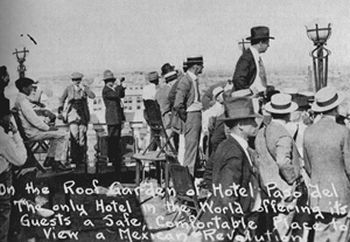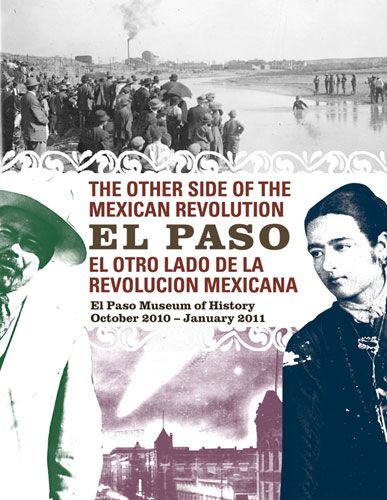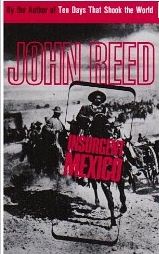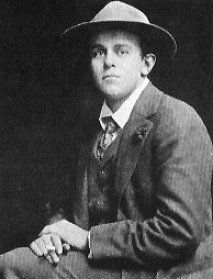
Publisher:
Bonnie King
CONTACT:
Newsroom@Salem-news.com
Advertising:
Adsales@Salem-news.com

~Truth~
~Justice~
~Peace~
TJP
May-13-2011 01:24

 TweetFollow @OregonNews
TweetFollow @OregonNews
Border History Lives On
Kent Paterson for Salem-News.comMuseo Urbano opens new intellectual doors for understanding El Paso’s historical roots and cultural legacies.
 El Paso residents view the Mexican Revolution from a safe location, the Roof Garden of Hotel Paso del [Norte:] Photo courtesy of the Library of Congress. |
(EL PASO, Tx.) - Dancing to the soaring cumbia sounds of Frontera Bugalu, a large crowd inaugurated El Paso’s newest gem this month. The fruit of patient planners and grassroots visionaries, Museo Urbano (Urban Museum) is now a reality.
Located at 500 South Oregon Street in the heart of El Paso’s historic Segundo Barrio, the volunteer-run museum came about through the efforts of local author David Romo and historian Dr. Yolanda Leyva, as well as the dedication of University of Texas at El Paso (UTEP) students and neighborhood residents who devoted time and energy to a project aimed at preserving and popularizing their history.
Museo Urbano opens new intellectual doors for understanding El Paso’s historical roots and cultural legacies, Romo told Frontera NorteSur in an interview.
“Segundo Barrio has never been declared a historic district and some of the more affluent areas in El Paso have,” Romo said. “Segundo Barrio is arguably one of the most important places of the Mexican diaspora. It is our Ellis Island.”
Nestled on the Rio Grande/Rio Bravo and facing Ciudad Juarez, Mexico, the Segundo Barrio has been the bridge between two nations. The working-class neighborhood has been the new home for multiple generations of immigrants, and has been fertile ground for political-cultural explosions like the Chicano movement of the 1960s and 1970s. And that’s just for starters.
 |
Occupying one end of an old but still inhabited tenement, Museo Urbano contains images, words and items of a complex and ever-evolving border history.
The museum’s walls display old photos that show, among other things, an ESL class for Chinese immigrants circa 1905 and the old towers of the American Smelting and Refining Company that became the geographic guideposts to El Paso and which are now scheduled for a controversial demolishing. An electronic screen flashes pictures from the May 1911 Battle of Juarez, a crucial event in determining the course of the Mexican Revolution.
A display of traditional herbs is another addition to the museum’s treasure trove, and considerable space is devoted to the story of curandera Teresita Urrea, the well-known healer, spiritualist and community activist of the early 20th century. Museo Urbano also offers books for sale on subjects like the Mexican Revolution and the calo slang born in the streets of El Paso.
In a big way, though, Museo Urbano is merely the portal of a much bigger and living museum- the Segundo Barrio and downtown El Paso. The museum’s founders have taken the time to prepare a detailed brochure and map any member of the public can use to undertake an 18-stop walking tour of historic sites in the Segundo Barrio and adjacent downtown.
Visits of possible interest include buildings that hosted early newspapers, theaters, labor organizations, hotels and Mexican revolutionary Pancho Villa’s consulate.
Museo Urbano’s description of La Patria Newspaper Press might remind readers of contemporary issues of press freedom and repression in Mexico. According to the museum, publisher Silvestre Terrazas, a fierce opponent of dictator Porfirio Diaz, was sued 150 times, imprisoned 12 times and sentenced to death by the strongman’s government.
A hundred years ago, we learn, El Paso was the nerve center of political intrigues, gunrunning operations and cross-border revolutionary causes.
 Order from Amazon |
 Journalist John Reed |
The museum brochure quotes the legendary journalist and international revolutionary chronicler John Reed: “El Paso, Texas, is the Supreme Lodge of the Ancient Order of Conspirators of the World. The personnel changes from year to year, but its purpose is always the same-to destroy the existing government of Mexico…a junta is in session at all hours of the day and night-revolutionary juntas, counter-revolutionary juntas and counter-counter revolutionary juntas.”
The building that houses Museo Urbano is a historic site itself, Romo stressed, sheltering a brothel of sorts at one point and later one of the Lebanese-Mexican families which were influential in the development of the sister cities of Ciudad Juarez and El Paso.
“To understand the history of a single building, you got to kind of understand the history of the world,” Romo observed.
The chair of UTEP’s history department, Dr. Yolanda Leyva collaborated with Romo in laying the groundwork for Museo Urbano. The recent Centennial commemoration of the 1910 Mexican Revolution finally “opened the door for us,” Leyva told Frontera NorteSur, and a small grant from Humanities Texas allowed the museum to begin operating.
“We need to keep this alive,” Leyva said. “Our money runs out June 15. We need to create an endowment.”
Leyva said neighborhood residents, including people who live in the same building housing Museo Urbano, have welcomed the project with enthusiasm. Inspired by the museum, local youth have painted murals on the walls surrounding the building, she said.
In celebrating a past history, the young people are making one of their own. Tears, reminiscences and joyful expressions have all surrounded the museum’s opening, Leyva added.
UTEP’s public historian recalled meeting one woman who showed off an old United Farm Workers membership card and recounted how she participated in a strike back in 1955-long before the farmworkers’ union was even founded.
Printed in the El Paso Times, a wrong starting time for the inaugural celebration actually benefited the event, Leyva added. The newspaper story listed an earlier time than was really the case, Leyva said, encouraging elderly people who tend to go to bed early to show up in the early afternoon.
Consequently, Leyva said she then got a wonderful earful of new stories about the Segundo Barrio of the 1920s and 1930s.
“We wouldn’t have gotten the 80 or 90 year-olds at 5 o’clock,” Leyva chuckled, “so thank God for that mistake.” Sitting down after putting long hours at the museum’s grand opening, Leyva agreed she had experienced a “magical day.”
For Romo, Museo Urbano is far more than just a physical space where visitors can relive the past. The author of a book on El Paso’s deep relationship with the Mexican Revolution, Romo characterized the museum as a project that represents a counter-narrative to elite versions of history, a people’s history from the point of view and experiences of “los de abajo,” or those at the bottom of society.
In a wider context, El Paso’s celebration of Museo Urbano comes at precisely the same time students and educators in Arizona are waging an intense battle to keep a highly-praised Mexican-American studies program from being dismantled by state mandate.
Locally, Museo Urbano marks a triumph for the Segundo Barrio, which was slated for urban redevelopment a few years ago until protests by residents forced modifications to the city plan. Museo Urbano, Romo said, is a concrete example of a historic preservation project that avoids the fate of places like the old Roma Hotel and Emporium Bar, which were important in Pancho Villa's El Paso adventures but nonetheless later razed to the ground. In their place, a Burger King now stands.
“Revitalization to us is problematic because a lot of the time it is ‘devitalization’,” Romo reflected. In contrast, “You can see the strength of the community, you can feel it,” he said, as groups of people-many of them young-filed through the new museum or twirled outside to the beat of Frontera Bugalu.
“We’re giving a positive vision of why our history and space are so important,” the borderland scholar summarized.
Both Leyva and Romo credited the hard work of UTEP students for making Museo Urbano possible. For now, the museum will be open to the public on Saturdays and Sundays from 10 am to 2 pm. Fundraisers and summer workshops are either in the works or already scheduled for the summer months.
Interested persons can find out more about Museo Urbano by calling the UTEP Department of History at 915-747-5508. The museum also maintains a Facebook page under its name.
Frontera NorteSur: on-line, U.S.-Mexico border news
Center for Latin American and Border Studies
New Mexico State University
Las Cruces, New Mexico
Articles for May 12, 2011 | Articles for May 13, 2011 | Articles for May 14, 2011

Quick Links
DINING
Willamette UniversityGoudy Commons Cafe
Dine on the Queen
Willamette Queen Sternwheeler
MUST SEE SALEM
Oregon Capitol ToursCapitol History Gateway
Willamette River Ride
Willamette Queen Sternwheeler
Historic Home Tours:
Deepwood Museum
The Bush House
Gaiety Hollow Garden
AUCTIONS - APPRAISALS
Auction Masters & AppraisalsCONSTRUCTION SERVICES
Roofing and ContractingSheridan, Ore.
ONLINE SHOPPING
Special Occasion DressesAdvertise with Salem-News
Contact:AdSales@Salem-News.com


Salem-News.com:

Terms of Service | Privacy Policy
All comments and messages are approved by people and self promotional links or unacceptable comments are denied.
[Return to Top]
©2025 Salem-News.com. All opinions expressed in this article are those of the author and do not necessarily reflect those of Salem-News.com.